Integrating innovative ideas into old district
Young people are always in search of opportunities to unleash their knowledge and creativity. In this regards, the Urban Renewal Authority (URA), in the course of urban
regeneration, endeavours to create platforms for young people to connect with the community and integrate their innovative ideas into the old districts. Through realisation of their creative ideas in old districts, they help make a difference to the residents as well as to their own self.
The URA and the Hong Kong Institute of Vocational Education (IVE) of the Vocational Training Council (VTC) joined hands to organise the “URA/IVE Innovative Design
Competition 2018” last December. With the theme of “innovative ideas for old districts”, the competition invited higher diploma students from the engineering programme of IVE and the architectural design programme of Hong Kong Design Institute (HKDI) to make use of their knowledge acquired in schools and their creativity to come up with a design concept or tool that can help enhance the daily lives of elderly. During the five-month competition, the URA has arranged for participants guided tours to sub-divided units in Sham Shui Po to experience the living condition of the elderly as well as to learn about the issues and challenges of urban renewal from different perspectives.
To prepare for the competition, Fong Ching, Year 2 student of IVE’s Architectural Studies and one of the participants of the competition, visited Hung Hom, Yau Tsim Mong and Sham Shui Po with her teammates Wong Man-chi and Chung Kin-ho to observe the livelihood in old districts. “The elderly living in dilapidated old building
has no room for rest as his/her cramped home is packed with household stuff and results in poor ventilation.”
Fong continued that, during their inspection of old buildings, they were astonished at those abandoned rooftops with piles of garbage including dismantled air-conditioner and unauthorised building works. She learnt from the elderly that, in the past, they used to mingle with their neighbours at the rooftops where they took water for their daily use. However, as such routine no longer exists, neighbours become isolated. Fong lamented: “What a waste to have so many abandoned rooftops and why can’t we turn it into a place that can improve the living environment of the elderly in the old districts?”
Having a deepened understanding of the urban decay problem, Fong and her team members came up with a creative design to enhance the living environment in old
districts. They designed a dome-like outdoor facility which could be placed on the rooftop of old buildings with an aim to provide a comfortable space for the elderly to enjoy. “The rooftop is the place where the elderly must go daily. They would rather walk up the stairs to rooftop than go downstairs and walk a few hundred metres to the park for leisure. As long as we make good use of the rooftop space with creativity, we can greatly improve the life of the elderly in the old districts.”
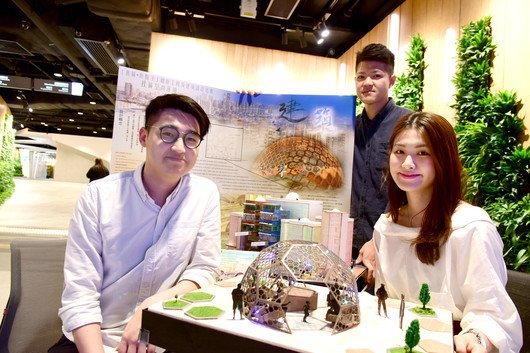 Year 2 Students of the Architectural Studies of IVE, Fong Ching (right), Wong Man-chi and Chung Kin-ho express care for the elders in old districts by creating a "dome-like" outdoor facility on rooftop to improve their living quality.
Year 2 Students of the Architectural Studies of IVE, Fong Ching (right), Wong Man-chi and Chung Kin-ho express care for the elders in old districts by creating a "dome-like" outdoor facility on rooftop to improve their living quality.
Fong continued that the “DOME” built with hexagonal patterns adopts a ventilated design. When sunlight shed on the hexagonal patterns and the people inside, the shadow would look like people sitting and relaxing in the shade of a banyan tree.“The DOME looks like the rising sun in daytime and half-moon in night time. Not only is the design practical, it can also beautify the old districts both in daytime and at night.”
They also noticed that a majority of elders in old districts always stay at home and are disconnected with the community. This inspired them to add some social harmony elements into their design. Fong and her teammates have added some hexagonal chairs with different levels. Those placed at upper level are for young people and children as they can climb up to the chairs to rest and thus bring vitality,
while those at lower level are tailor-made for elderly based on their most comfortable seated angle.
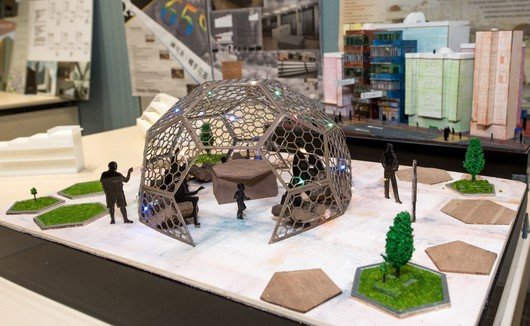 The "DOME" helps the elderly people reintegrate into the community, adding social harmony to the community.
The "DOME" helps the elderly people reintegrate into the community, adding social harmony to the community.
The design was awarded the “Excellence Award” and “Most Innovative Award” in the Finale of the competition. Fong thinks that the competition provided them an invaluable platform to apply their academic knowledge and creativity to express care to the community and is a big recognition to the innovative ideas of young people.
The URA has been encouraging young people to explore urban renewal from different perspectives through collaboration with tertiary institutions and district
organisations for education, outreach and volunteer services. These services allow the URA and the young people to express care for the residents of the old district
as well as unleash young people’s creativity, bringing them with a different learning experience. At the beginning of this year, the URA has also collaborated with the HKDI to invite students from the design stream to create promotional banners and posters for the Lunar New Year promotion at the temporary hawker bazaar located in the Kwun Tong Town Centre Project. The partnership aims to promote the bazaar, and at the same time provide a platform for young people to showcase their creativity.
Mr. Lo, who sells stationery at the bazaar, pointed to the New Year Lion image on the poster and said: “This Lion can bring out the Lunar New Year atmosphere and
the Chinese traditional features. It reminds me of my good old days working in a hotel where I had to bring the Lion to different departments to celebrate the new
year on the second day of Lunar New Year.” Mr. Lo praised the design work by Ron, a Year One student of the HKDI diploma of foundation studies-design.
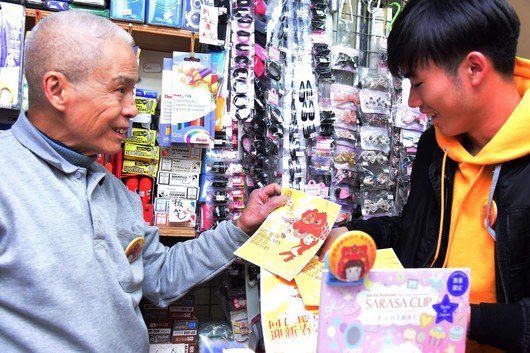 Mr. Lo, who owns a stall at the temporary hawker bazaar in Kwun Tong, praised the design work by Ron for its festivity mood.
Mr. Lo, who owns a stall at the temporary hawker bazaar in Kwun Tong, praised the design work by Ron for its festivity mood.
Ron was happy to share his creative ideas with Mr Lo. “To align with the theme about Chinese New Year, bazaar and community, I’ve added many human touch that makes the design vivid, such as a girl in a red Chinese dress playing lion dance surrounded by many people who appreciate fireworks.”
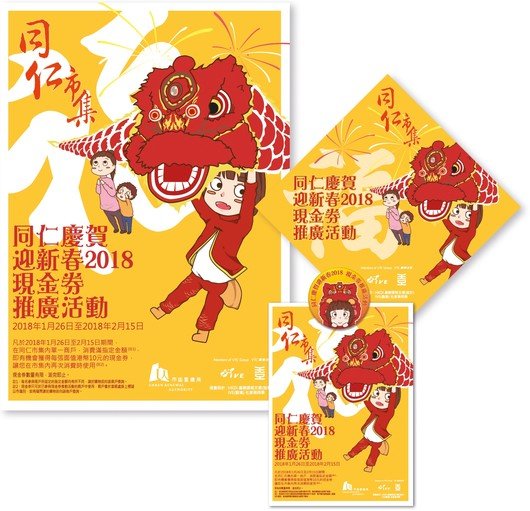 Ron adopts new year celebration, characteristics of the hawker bazaar and the community as the theme of his desoign work.
Ron adopts new year celebration, characteristics of the hawker bazaar and the community as the theme of his desoign work.
On weekdays, Ron attends classes at the IVE Kwun Tong campus and so he himself is a “kai-fong” (neighbour) of Kwun Tong. “This design opportunity has given me
a deeper understanding of the variety of goods sold in the bazaar and I appreciate the close neighbourhood relationship between the hawker stall owners and the kaifongs.” He added that in the past he used to participate in design competitions, while this is the first time that he worked out a design for the community. “Designing for the community requires special attention to the people and the environment. It gives me great satisfaction as my work was displayed on the buildings in the community.”
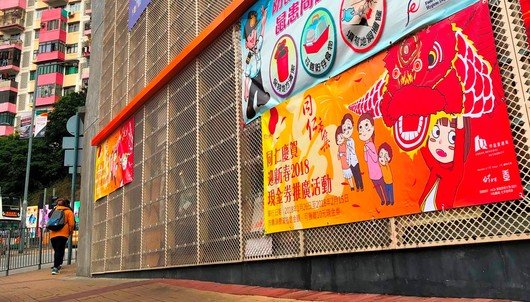 The giant poster designed by Ron was displayed at the hawker bazaar during the Lunar New Year.
The giant poster designed by Ron was displayed at the hawker bazaar during the Lunar New Year.
Ron’s instructor, Mr. Lai, lecturer of the HKDI design section, said that Year One design student like Ron are only beginners in design and their technical skills may not be perfect.“ However, this collaboration with the URA provides a rare opportunity for students to gain practical experience by applying their creative design to the community.” Mr. Lai reckons the creativity platform provided by the URA can enrich students’ understanding of the community. He hopes that the URA will provide more
creative platforms so as to allow young people to integrate their ideas into the community.
